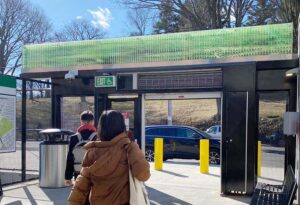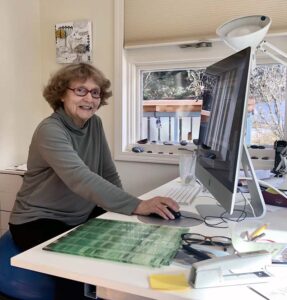By Maureen Belt
While thousands of commuters impatiently waited years for the MBTA to extend its Green Line to the Tufts campus in Medford, Lincoln resident Nancy Selvage was at home shaping the art to characterize the new station.
Her contribution to GLX (the MBTA’s Green Line Extension project) took more than seven years from the day she was granted the commission. It finally saw the light of day (actually predawn) at 4:40 a.m. on Dec. 12, 2022, when the Medford/Tufts station opened to large crowds and great fanfare including a ribbon cutting. In a later interview with the Lincoln Squirrel, she pulled up a Twitter post of then-Gov. Charlie Baker, Sen. Elizabeth Warren, and other dignitaries flashing big smiles while cutting a ribbon at the inauguration. One of Selvage’s newly installed pieces, “Speeding Green Line,” was a prominent backdrop.
“I’m not a Twitter follower myself,” she remarked. “Someone forwarded this to me.”
“Speeding Green Line” and the station’s wayfinder signs — platform indicators that give commuters information — are now part of Selvage’s public art work portfolio, which includes an installation at the Google building lobby in Cambridge and at the Canyon Rim in Arizona, among others. Selvage incorporates location, environment, and usage into all of her work.
In an earlier plaza design that was later scrapped due to budget cuts, the purpose of the GLX art was to camouflage unsightly ductwork and to compensate for the lack of landscaping. The current purpose is to simulate the visual effect of trees speeding past a moving train.
“Speeding Green Line” consists of two 22-foot-long, 120-pound backlit glass panels placed over the Medford/Tufts entrance. Selvage made complex blueprints and engineered a design to ensure the finished art would hold up to New England weather and the expected hustle and bustle of a long-overdue light-rail station. Aesthetically, she meticulously designed it to reflect light and, though static, give the appearance of motion as one passes by.
“The piece is activated by the view of movement,” said Selvage.
On the station platform, the artwork suggests a correspondence between commuters and honeybees in a sequence of four panels: setting forth (flying off), finding sustenance (foraging), returning to nourish a community (back home), and sharing news of the journey (waggle dance). The images were created digitally by collaging and warping photographic details of Selvage’s perforated metal sculptures.
She was unaware at the time that Tufts University was the first urban campus in Massachusetts to be certified in the Bee Campus USA program. Selvage is also a Tufts alumna — she holds an MFA in sculpture from the School of the Museum of Fine Arts/Tufts University as well as a BA in art history from Wellesley College. Gardens maintained by the Tufts Pollinator Initiative at four sites on campus contain native plants to feed a diversity of pollinators, according to a December 2022 article about Selvage’s work in TuftsNow.
“It’s about coming and going and finding your way,” she said, comparing her images of bees on their journey of finding nectar to “commuters finding sweetness in the city.” (Click here to see detailed proof images.)
Selvage’s creativity is only one of the ingredients that are essential to her multilayered work. She also needs plenty of patience, trust in others, the ability to work within budget constraints and, in the case of public art, a tolerance for multiple bureaucratic meetings.
As with any major project, challenges cropped up. When sketching ideas for “Speeding Green Line,” she wanted natural shades of green. She toyed with iPhone photos of local summer foliage, but the images became blurred when enlarged using Photoshop. She then hired a photographer with a high-resolution digital camera, so images of individual pine needles and oak leaves remained vivid.
Once digitally expanded across 22 feet, she captured the green abstract lines she sought. Intentionally, she added a thin colorless vertical stripe every few inches, necessary to give the effect of motion. Selvage then delivered her files to a fabrication company with expertise in printing and a kiln to fuse her images onto hurricane-proof glass. Despite that precaution, installers broke one of the panels during the installation. It had to be refabricated and installed a few weeks after the opening.
Selvage’s honeybees hover about curved blossoms, also of her creation, on the 4-foot by 18-foot wayfinder signs. The blossoms, which look like calla lilies, are actually warped and altered photographs of a variety of Selvage’s metal sculptures.
The same photographer was hired to take high-resolution photos of the pieces. Selvage Photoshopped the images into cartoonish flowers. She made the bees from details of other 3-D pieces, then worked to proportion each bee to a flower. One oversized bee performs a waggle dance, a rhythmic, geometric succession of rapid movements performed to announce they’ve found the cache.
“It took forever to do these bees,” Selvage said. “It just took forever.”
Once the honey bees were situated, the MBTA outsourced her work to a factory for printing the images on metal panels. Unhappy with the results, the agency shopped around for other niche companies. “The only thing I could say is that the yellows are too orange,” Selvage said. But the second time was the charm.
After factoring in supplies, payments to vendors and other expenses, Selvage barely broke even on her predetermined design fee. But she isn’t in it for the money. Interactive art is a passion she turned into a lifelong career. Other public installations by Selvage in the Boston area include “Hydro” in Lowell and “Water Wall” in Trolley Square in Cambridge, and she’s excited about a project to sculpt an interactive gathering place for children in Virginia.
“I’m totally comfortable in three dimensions,” Selvage said. “There’s nothing better than a big empty space. On the other hand, there’s nothing worse than a blank canvas.”


Leave a Reply